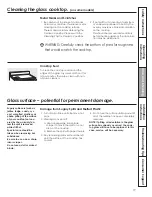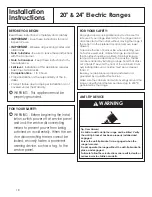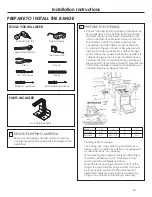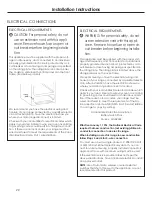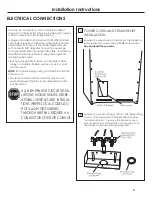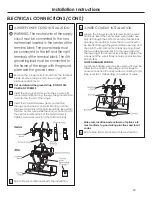
8
Safety Instructions
Operating In
stru
ctio
ns
Care and Cleaning
Troubleshooting Tips
Consumer Support
Installation In
stru
ctio
ns
Stainless Steel:
recommended
Selecting types of cookware.
The following information will help you choose cookware that will give good performance on glass cooktops.
Check for flat bottoms by us-
ing a straight edge.
Pans with rounded, curved,
ridged or warped bottoms are
not recommended.
Home Canning Tips:
Be sure the canner is centered over the
surface unit.
Make sure the canner is flat on the bot-
tom.
Use recipes and procedures from repu-
table sources. These are available from
manufacturers such as Ball® and Kerr®
and the Department of Agriculture Exten-
sion Service.
To prevent burns from steam or heat, use
caution when canning.
Stoneware:
usable, but not recommended
Poor performance. May scratch the sur-
face.
Glass-ceramic:
usable, but not recommended
Poor performance. May scratch the sur-
face.
Porcelain Enamel Covered Cast Iron:
recommended
As long as the cookware is covered com-
pletely with porcelain enamel, this cook-
ware is recommended. Caution is recom-
mended for cast-iron cookware that is not
completely covered with smooth porce-
lain enamel, as it may scratch the glass-
ceramic cooktop.
Copper Bottom:
recommended
Copper may leave residues which can ap-
pear as scratches. The residues can be re-
moved, as long as the cooktop is cleaned
immediately. However, do not let these
pots boil dry. Overheated metal can bond
to glass cooktops. An overheated copper
bottom pot will leave a residue that will
permanently stain the cooktop if not re-
moved immediately.
Aluminum:
heavy weight recommended.
Good conductivity. Aluminum residues
sometimes appear as scratches on the
cooktop, but can be removed if cleaned
immediately. Because of its low melting
point, thin-weight aluminum should not be
used.

















